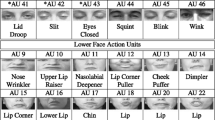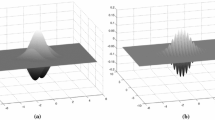Abstract
This paper presents an approach to detect personal highlights in videos based on the analysis of facial activities of the viewer. Our facial activity analysis was based on the motion vectors tracked on twelve key points in the human face. In our approach, the magnitude of the motion vectors represented a degree of a viewer’s affective reaction to video contents. We examined 80 facial activity videos recorded for ten participants, each watching eight video clips in various genres. The experimental results suggest that useful motion vectors to detect personal highlights varied significantly across viewers. However, it was suggested that the activity in the upper part of face tended to be more indicative of personal highlights than the activity in the lower part.






Similar content being viewed by others
References
Arifin S, Cheung P (2007) A computation method for video segmentation utilizing the pleasure-arousal-dominance emotional information. In: ACM international conference on multimedia
Calvo R, D’Mello S (2010) Affect detection: an interdisciplinary review of models, methods, and their applications. IEEE Trans Aff Comp 1(1):18–37
Chan CH, Jones GJF (2005) Affect-based indexing and retrieval of films. In: ACM international conference on multimedia, pp 427–430
Chen L (2000) Joint processing of audio-visual information for the recognition of emotional expressions in human-computer interaction. PhD thesis, University of Illinois at Urbana-Champaign
Cheon Y, Kim D (2009) Natural facial expression recognition using differential-AAM and manifold learning. Pattern Recogn 42(7):260–274
Cohen I, Sebe N, Chen L, Garg A, Huang T (2003) Facial expression recognition from video sequences: temporal and static modeling. Comput Vis Image Underst 91(1–2):160–187
Cohen I, Sebe N, Cozman F, Cirelo M, Huang T (2004) Semi-supervised learning of classifiers: theory, algorithms, and applications to human-computer interaction. IEEE Trans Pattern Anal Mach Intell 26(12):1553–1567
Dietz R, Lang A (1999) Aefective agents: effects of agent affect on arousal, attention, liking and learning. In: Cognitive technology conference
Ekman P, Friesen W (1978) Facial action coding system: investigator’s guide. Consulting Psychologists Press, Palo Alto
Hanjalic A (2006) Extracting moods from pictures and sounds: towards truly personalized TV. IEEE Signal Process Mag 2(23):90–100
Hanjalic A, Xu LQ (2005) Affective video content representation and modeling. IEEE Trans Multimedia 7(1):143–154
Hanjalic A, Lienhart R, Ma WY, Smith JR (2008) The holy grail of multimedia information retrieval: so close or yet so far away? Proc IEEE 96(4):541–547
Huijsmans D, Sebe N (2005) How to complete performance graphs in content-based image retrieval: add generality and normalize scope. IEEE Trans Pattern Anal Mach Intell 27(2):245–251
Jaimes A, Gatica-Perez D, Sebe N, Huang T (2007) Human-centered computing: towards a human revolution. IEEE Comp 5(40):30–34
Joho H, Jose JM, Valenti R, Sebe N (2009) Exploiting facial expressions for affective video summarisation. In: ACM international conference on image and video retrieval (CIVR)
Kang H (2002) Analysis of scene context related with emotional events. In: ACM international conference on multimedia
Madigan D, York J (1995) Bayesian graphical models for discrete data. Int Stat Rev 63:215–232
Mehrabian A (1996) Pleasure-arousal-dominance: a general framework for describing and measuring individual differences in temperament. Curr Psychol 14(4):261–292
Moncrieff S, Dorai C, Venkatesh S (2001) Affect computing in film through sound energy dynamics. In: ACM international conference on multimedia
Money A, Agius H (2008) Feasibility of personalized affective video summaries. In: Affect and emotion in human—computer interaction. Springer
Money A, Agius H (2008) Video summarisation: a conceptual framework and survey of the state of the art. J Vis Commun Image Represent 19(2):121–143
Mooney C, Scully M, Jones GJF, Smeaton AF (2006) Investigating biometric response for information retrieval applications. In: European conference on information retrieval, pp 570–574
Over P, Smeaton AF, Kelly P (2007) The TRECVID 2007 BBC rushes summarization evaluation pilot. In: TVS ’07: Int. workshop on TRECVID video summarization, pp 1–15
van Rijsbergen CJ (1979) Information retrieval, 2nd edn. Butterworths
Sebe N, Cohen I, Cozman F, Huang T (2005) Learning probabilistic classifiers for human-computer interaction applications. Multimedia Syst 10(6):484–498
Soleymani M, Chanel G, Kierkels JJ, Pun T (2008) Affective ranking of movie scenes using physiological signals and content analysis. In: ACM workshop on multimedia semantics, pp 32–39
Sung J, Kanade T, Kim D (2008) Pose robust face tracking by combining active appearance models and cylinder head models. Int J Comput Vis 80(2):260–274
Tao H, Huang T (1998) Connected vibrations: a modal analysis approach to non-rigid motion tracking. In: IEEE conference on compter vision and pattern recognition, pp 735–740
Tjondronegoro D, Chen YP, Pham B (2004) Highlights for more complete sports video summarization. IEEE Multimed 11(4):22–37
Wang H, Cheong L (2006) Affective understanding in film. IEEE Trans Circuits Syst Video Technol 16(6):689–704
Xu M, Chia L, Jin J (2005) Affective content analysis in comedy and horror videos by audio emotional event detection. In: IEEE international conference on multimedia and expo
Acknowledgements
Funding was provided by the MIAUCE Project (EU IST-033715). Any opinions, findings, and conclusions described here are the authors and do not necessarily reflect those of the sponsor. The work of Jacopo Staiano and Nicu Sebe has been supported by the FP7 IP GLOCAL european project and by the FIRB S-PATTERNS project.
Author information
Authors and Affiliations
Corresponding author
Rights and permissions
About this article
Cite this article
Joho, H., Staiano, J., Sebe, N. et al. Looking at the viewer: analysing facial activity to detect personal highlights of multimedia contents. Multimed Tools Appl 51, 505–523 (2011). https://doi.org/10.1007/s11042-010-0632-x
Published:
Issue Date:
DOI: https://doi.org/10.1007/s11042-010-0632-x




